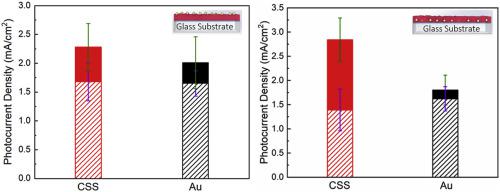Materials Today Energy ( IF 9.3 ) Pub Date : 2020-10-28 , DOI: 10.1016/j.mtener.2020.100576 A. Dutta , B. Pihuleac , Y. Chen , C. Zong , L. Dal Negro , C. Yang

|
Photoelectrochemical (PEC) water splitting for hydrogen generation using abundantly available solar energy is a promising strategy toward developing a carbon-neutral society. Here, we demonstrate the first use of Au@SiO2@Au core-shell-shell (CSS) plasmonic nanoparticles (NPs) for improvement of the photocatalytic performance in PEC photoanodes using hematite as a testing system. Using rigorous calculations based on the Mie scattering theory on CSS NPs, we have designed and optimized the dimensions of each layer in the CSS NPs for the double resonance peaks of the CSS NPs with maximal contribution to the enhancement of the hematite PEC activity. Two different NP/hematite architectures on synthesized Sn-doped hematite nanocoral films have been studied – a top-deposited configuration with the optimized CSS NPs on the surface of the hematite, and an embedded configuration with the hematite nanocorals grown over the optimized CSS NPs. Compared with the bare hematite, the average photocurrent density, as a measure of the PEC activity, was found to be improved by 0.6 mA/cm2 and 1.45 mA/cm2 for the top-deposited and embedded CSS NP/hematite configurations, respectively. In particular, the best embedded sample showed an improvement in the photocurrent density from 0.82 mA/cm2 for the bare hematite to 3.0 mA/cm2. This improvement of 2.18 mA/cm2 is one of the highest improvements gained from a plasmonic enhancement strategy for a hematite photoelectrocatalytic system. In addition, the CSS NPs outperformed Au NPs by 1.67 times in the top-deposited configuration and up to 8 times in the embedded configuration. Our simulation and experiment results showed the following key features of CSS NPs which are critical for improving the photocurrent of hematite: (1) a double resonance peak, each of which can contribute separately to the photocurrent, (2) easy tunability of the peaks by varying the dimensions of the CSS NPs and subsequently making the plasmonic peaks strongly scattering or strongly absorbing, thereby optimizing the contributions to the PEC activity of hematite, and (3) spatially uniform electric field distributions which extend 20–25 nm from the outer surface and hence offer potential of increasing carrier generation. Our results show CSS NPs as new and improved plasmonic systems for enhancing PEC performance.
中文翻译:

Au @ SiO2 @ Au核-壳-壳纳米粒子增强赤铁矿的光催化活性
使用大量可用的太阳能进行光化学(PEC)分解水制氢是发展碳中性社会的有前途的策略。在这里,我们演示了Au @ SiO 2的首次使用@Au核-壳-壳(CSS)等离子体纳米颗粒(NPs),用于使用赤铁矿作为测试系统来改善PEC光阳极中的光催化性能。使用基于CSS NP的Mie散射理论的严格计算,我们针对CSS NP的双共振峰设计和优化了CSS NP中每一层的尺寸,从而最大程度地提高了赤铁矿PEC活性。研究了合成的Sn掺杂的赤铁矿纳米珊瑚膜上的两种不同的NP /赤铁矿体系结构–顶部沉积的结构,在赤铁矿表面上具有优化的CSS NP,以及嵌入式结构,其中在优化的CSS NP上生长有赤铁矿纳米珊瑚。与裸露的赤铁矿相比,作为测量PEC活性的平均光电流密度提高了0。顶部沉积和嵌入的CSS NP /赤铁矿配置分别为2和1.45 mA / cm 2。特别地,最好的嵌入式样品显示光电流密度从裸露的赤铁矿的0.82 mA / cm 2提高到3.0 mA / cm 2。这种改进为2.18 mA / cm 2是赤铁矿光电催化系统的等离激元增强策略获得的最高改进之一。另外,在顶部沉积配置中,CSS NP的性能比Au NP高1.67倍,在嵌入式配置中则高达8倍。我们的仿真和实验结果表明,CSS NP的以下关键特征对于改善赤铁矿的光电流至关重要:(1)一个双共振峰,每个共振峰可分别对光电流做出贡献;(2)通过改变CSS NP的尺寸,随后使等离子体峰强烈散射或强烈吸收,从而优化对赤铁矿PEC活性的贡献,(3)从外表面延伸20-25 nm的空间均匀电场分布,因此有可能增加载流子的产生。我们的结果表明CSS NP是增强PEC性能的新型和改进的等离子体系统。

























 京公网安备 11010802027423号
京公网安备 11010802027423号